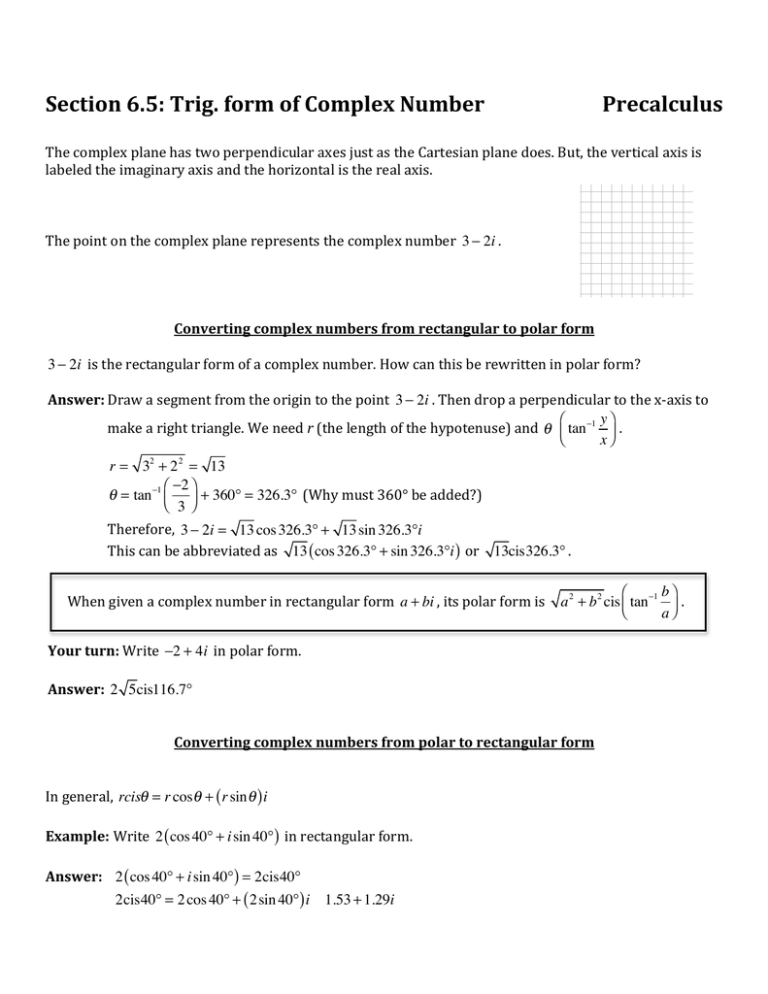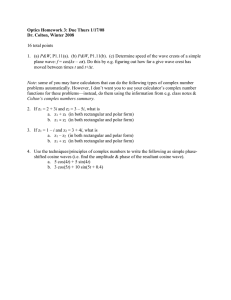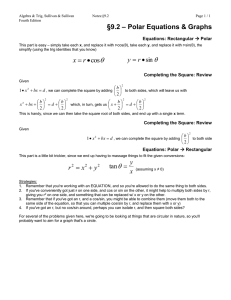Section 6.5 notes
advertisement

Section 6.5: Trig. form of Complex Number Precalculus The complex plane has two perpendicular axes just as the Cartesian plane does. But, the vertical axis is labeled the imaginary axis and the horizontal is the real axis. The point on the complex plane represents the complex number 3 − 2i . Converting complex numbers from rectangular to polar form 3 − 2i is the rectangular form of a complex number. How can this be rewritten in polar form? Answer: Draw a segment from the origin to the point 3 − 2i . Then drop a perpendicular to the x-­‐axis to y⎞ ⎛ make a right triangle. We need r (the length of the hypotenuse) and θ ⎜ tan −1 ⎟ . ⎝ x⎠ r = 32 + 2 2 = 13 ⎛ −2 ⎞ θ = tan −1 ⎜ ⎟ + 360° = 326.3° (Why must 360° be added?) ⎝ 3⎠ Therefore, 3 − 2i = 13 cos 326.3° + 13 sin 326.3°i This can be abbreviated as 13 ( cos 326.3° + sin 326.3°i ) or 13cis326.3° . b⎞ ⎛ When given a complex number in rectangular form a + bi , its polar form is a 2 + b 2 cis ⎜ tan −1 ⎟ . ⎝ a⎠ Your turn: Write −2 + 4i in polar form. Answer: 2 5cis116.7° Converting complex numbers from polar to rectangular form In general, rcisθ = r cosθ + ( r sin θ ) i Example: Write 2 ( cos 40° + i sin 40° ) in rectangular form. Answer: 2 ( cos 40° + i sin 40° ) = 2cis40° 2cis40° = 2 cos 40° + ( 2 sin 40° ) i 1.53 + 1.29i Your turn: Express 3cis80° in rectangular form. Answer: 0.52 + 2.95i Absolute Value of a Complex Number Recall that the absolute value of a number is its distance from zero on the number line. Similarly, the absolute value of a complex number is its distance from the origin. What, then, is 3 − 2i ? Answer: 13 Multiplying two Complex Numbers (Rectangular Form) To multiply two complex numbers written in rectangular form, use FOIL. Example: Simplify ( 2 + 3i ) ( 3 − 4i ) Solution: ( 2 + 3i ) ( 3 − 4i ) = 6 − 8i + 9i − 12i 2 = 6 + i + 12 = 18 + i Multiplying two Complex Numbers (Polar Form) ( r1cisα ) ( r2 cisβ ) = r1r2 cis (α + β ) Example: Simplify ( 2cis30° ) ( −3cis40° ) Solution: ( 2cis30° ) ( −3cis40° ) = ( 2 ) ( −3) cis ( 30° + 40° ) = 6cis70° Dividing two Complex Numbers (Polar Form) r1cisα r = 1 cis (α − β ) r2 cisβ r2 Example: Simplify 2 ( cos120° + i sin120° ) 4 ( cos 40° + i sin 40° ) Solution: 2 ( cos120° + i sin120° ) 2cis120° 2 1 = = cis (120° − 40° ) = cis80° 4 ( cos 40° + i sin 40° ) 4cis40° 4 2 Dividing two Complex Numbers (Rectangular Form) Rationalize the denominator. Example: Simplify ( 2 + 3i ) ÷ ( 4 − 5i ) 2 + 3i 4 + 5i 8 + 10i + 12i + 15i 2 −7 + 22i ⋅ = = −0.17 + 0.54i Solution: 2 4 − 5i 4 + 5i 16 + 20i − 20i − 25i 41 Assn: p. 478 VC#1 E #1-­‐11 odd, 17, 21, 25, 31, 37, 47, 49, 52, 53, 55, 57, 59, 61, 65, 66


